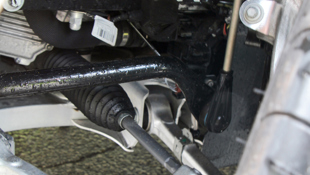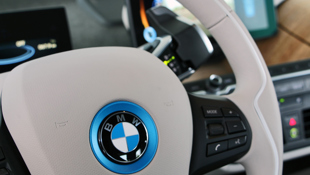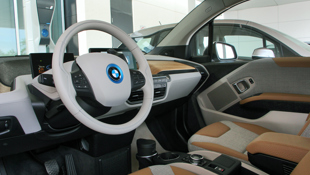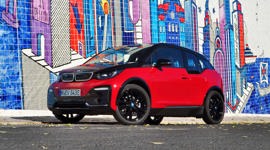Review and photos by Jonathan Yarkony
The i3 has landed.
Although it’s small, a little bit goofy looking (okay, a lot goofy looking), and unlikely to sell more than a handful, the BMW i3 is a bit of a big deal. BMW’s electric program has been seven years in the making, and in that time their research has shown consumer attitudes changing from critical to curious. The people are ready.
It’s been a while since any established, full-line manufacturer has launched a dedicated electric vehicle line, and BMW is jumping in with both feet. The i3 is the practical city runabout, and the i8 sports car will follow soon after. Though they look incredibly different, they both follow the same design aesthetic and guiding philosophies. And although the i8 is dead sexy, it is the i3 that took home the World Car Design of the Year Award, the jury taking particular note of its “radical leap in interior design” and its strong BMW brand identity but with a character all its own.
BMW is completely invested in electric mobility and what started with fanciful concepts has been shaped by over 21,000,000 km of real-world testing data with limited-run models like the Mini E and BMW ActiveE. BMW has also wisely invested in their own carbon-fibre research and production capacity, which has not only paved the way for weight and performance advantages in their electric program, but also transfer over to their performance and luxury vehicles.
The BMW i3 is based on a two-part structure: the drive module and the passenger cell. The lightweight CFRP (carbon-fibre-reinforced plastic) passenger cell is bonded and screwed to the drive module, which houses the battery, electric motor and, where applicable, the combustion engine. With such highly segmented structures, it will be incredibly easy to design different body types around the underlying architecture. Renderings of a mid-sized wagon vehicle type have already surfaced.
The i3 is a four door hatchback, with an extremely roomy front seat and a tight back seat that is easy to access thanks to reverse-opening rear doors. The trunk is small, comparable to smaller subcompacts. Exterior dimensions are similar to the Honda Fit or Nissan Verssa Note, though shorter in length, taller and a bit wider. Turning radius is better than either of those at about 5.0 m, a strong asset in a city car. With a standard back-up camera, this is one easy car to park.
No matter the cabin attached, the vehicle should maintain the near 50:50 weight distribution and low centre of gravity facilitated by the heavy batteries encased under the vehicle floor, aluminum platform and extremely light yet rigid cabin structure. In this case, the i3 weighs in at 1,297 kg (1,420 kg for the range-extended version) and promises comparable or superior crashworthiness properties, though it has yet to complete its North American crash testing regimen.
As with any electric vehicle, the biggest question is range. The i3 is estimated at 160 km of electric range courtesy of a 18.8 kWh lithium-ion battery. A level 2 charging unit will ‘fill it up’ overnight, while normal household outlet power would give you enough power (80 percent from standard household outlet in about 8 hours) to get safely to and from work for your average urban commute (BMW data suggests average daily round trip is 47 km). Full charge from empty using a standard household outlet would take about 20 hours, but as little as 3.5 hours using the level 2 charger.
The electric motor is good for 170 hp and 184 lb-ft of torque, and the little things zip along with plenty of zap. BMW pegs acceleration at 7.2 seconds to 100 km/h, but it is the 0–40 that is truly rewarding (about 3.7 seconds to 60 kph), the instantaneous torque offering a surge off the line that would make for excellent in-city scooting.
Handling is downright shocking. You look at its tall, ungainly proportions and think it is going to lean like an old Citroën, but with all its weight under your feet, there is surprisingly little body roll (though we did not drive particularly aggressively) and there is surprising grip from the tall, skinny tires (as equipped we sampled the 20-inch wheel option with 155/60R20 rubber in front and 175/55R20 in back – note how awkwardly skinny they look in pictures). No doubt the ride is a tad firm, but the CFRP structure is solid and the front MacPherson and rear five-link suspension does an amazing job of maintaining grip and alleviating excessive impact shock from affecting the cabin and its occupants.
However, between the light weight, easy access to torque, low centre of gravity and quick steering response but hefty steering weight, the car is a joy to pilot. Approach a corner and it requires a bit of elbow to get the wheel moving, but the car translates input precisely and turns in sharply, so tight turns and lane changes are simple joys to be found in every drive, much like BMW’s other city car, the Mini, though not to that degree.
The Range Extender option adds 140 km of range from a 0.65 L two-cylinder engine (38 hp and 41 lb-ft of torque but it serves only to charge the battery) and 7 L gas tank for a total range of 300 km. The added weight slows it down to nearly eight seconds to reach 100 km/h. and shifts more of the weight to the back, where the electric motor and gas engine reside. This option is for those who have a hard time letting go of their range anxiety.
In order to alleviate said anxiety, BMW offers a flex mobility option, whereby customers can book a BMW 3 Series or Mini Cooper for any isolated extended trips outside their usual range, limited to 10 over the duration of ownership. That being said, this isn’t the car for someone that regularly travels between Montreal and Toronto or any other long-distance travel. There is no equivalent to the Tesla Supercharger network to enable long-distance electric travel, nor are there plans to establish one.
However, there are a variety of tools for i3 owners to use in order to enable anxiety-free travel. The standard navigation system includes a range radius to show your safe travel zone and the car is connected to the Plug’n Drive network that collects information for public charging stations, which BMW estimates will grow by leaps and bounds over the coming years. The navigation upgrade that comes with either of the interior upgrades makes this a dynamic range, which will plot out the range based on the effect of route speed, traffic and terrain on the vehicle's electric range.
BMW will also assist in the assessment of level 2 home charging stations and referring an installation tech through their Bosch partners and even solar panels through their Pure Energies partners, with various payment alternatives and income opportunities. The home charging station is a piece of design in itself, the same design cues as seen on the car, and thoughtful touches like a tray for your keys or phone while you plug in, a security passcode and a 7.5 m cable, which should be long enough to reach past one car in the driveway so you don’t have to swap cars.
BMW is trying to go beyond selling an electric vehicle and into comprehensive sustainable mobility under the i brand and their 360 Electric philosophy, which include the above home-charging infrastructure, public charging information through the nav system or BMW’s new smartphone app for i3 owners, flexible mobility (loaner cars) and further assistance services.
Pricing starts at $44,950 with the ‘Loft’ interior theme and offers two interior upgrades: ‘Suite’ for an added $4,500 featuring full leather seats in black and brown; and ‘Lodge’, at $3,500, was my favourite with a gorgeous light woolen cloth and natural leather combo that looks stunning. Both the upgrades add that open-pore eucalyptus wood dash insert that finishes the interior beautifully. Those seats are artful, but also comfortable, with manual adjustments for height, reach and recline and standard front seat heating. You can also opt for a $2,500 Tech package that upgrades the nav system, adds Sirius satellite radio and a variety of BMW services and apps.
Ergonomically, the car is as good as most BMW products, with a sophisticated graphic interface and knob controller, conventional climate control buttons, slick preset buttons for audio, phone or navigation favourites and a novel but cool and intuitive column-mounted ‘transmission’ shifter (back for Reverse, forward for Drive), though the Park and Power buttons I found confusing.
|
Related Articles: Manufacturer's Website: Photo Gallery: |
While I can’t say that I find its pug face or tall, functional proportions aesthetically pleasing, I love the simplicity and modernity of the design, and the interior is an aesthetic delight, with an interesting mix of materials, all of which have been considered for a sustainable product. It seems to have captured that BMW driving quality and spirit of innovation that have built their reputation for excellence, and this in a boxy little subcompact electric car. Imagine what they could do with a sports car. Bring on the i8.
Pricing: 2014 BMW i3
Base Price: $44,950
Base Price (with Range Extender): $48,950
Options: Lodge interior $3,500, Suite interior $4,500, DC Fast Charging $750, Technology package $2,500 (Harman/Kardon sound system, BMW Online, real-time traffic, camera-based cruise/collision detection/routing)























